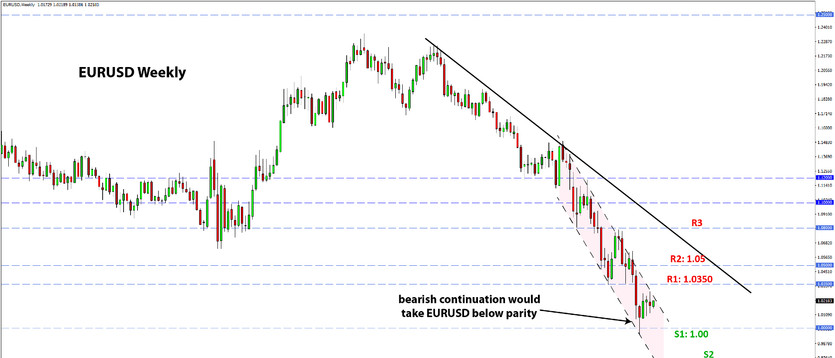Note: The FxTR newsletter will take a break from August 15-29; Stay tuned for our special edition to be released this Wednesday (August 10), where we will discuss the US dollar and the long-term outlook for the second half of this year.
USD Fundamentals: Blowout Nonfarm Payrolls Reinvigorates Dollar Bulls
The dollar regained some bullish momentum at the end of the past week on that much better than expected Nonfarm payrolls report. In a way, the NFP was a reversal of the pessimism from the week before when the GDP report showed the US had entered a technical recession.
However, as we noted in the previous weekly Fx analysis, technical recession is not equal to a real recession. The economic reports released last week are a case in point, first with the ISM manufacturing and services PMI reports, which were also notably better than expected. Then, Friday’s NFP was a blowout to the upside. All components of the jobs report were stronger than expected, with a massive 528k NFP and the unemployment rate falling to 3.5%. The key component for inflation – wage growth – was also notably higher than forecasted (5.2% vs 4.9% expected).
All in all, Friday’s Nonfarm payrolls report in no way suggests the economy is cooling as much as many feared. It strengthens the case that the Fed will need to stay firmly on the aggressively hawkish path. This has already led to markets reversing the moves from a week earlier, with the dollar now stronger again and US Treasury yields rising. This should support the USD into this week and beyond. Potentially, this may also be the start of a new bullish leg from here.
The CPI inflation report is the key focus on this week’s US economic calendar. Another high CPI print will cement expectations for more aggressive Fed rate hikes, especially given the blowout NFP report last Friday. This could be a very bullish scenario for the US dollar this week.
EUR Fundamentals: Long-term Bearish Factors Remain Dominant
In what is a quiet two-week period on the Eurozone calendar, the EUR currency remains largely driven by long-term geopolitical and external factors. EURUSD has been in consolidation since mid-July but appears heavy, as investors are unwilling to buy the euro given the bleak outlook for economic growth in the Eurozone.
The war in Ukraine and the hostile EU-Russia relations are and will likely remain the biggest bearish factor for the euro. European gas prices remain near record highs around 200 EUR/MWh, which will keep the euro under pressure. There is also the political uncertainty in Italy as another factor that exerts bearish pressures on the currency. Taken all together, both of these large-scale factors will likely keep the euro under heavy downside pressures over the coming months, meaning an eventual break below parity for EURUSD is a realistic scenario.
The light calendar this week features only 2nd tier releases due, which won’t have much of a market impact. Thus, the global appetite for dollars and risk sentiment will continue to have a bigger immediate impact on EURUSD and the other EUR pairs.
EURUSD Technical Analysis:
Although it almost reached 1.03, EURUSD remained in the consolidation range roughly between 1.01 and 1.0250 over the past week. The trend here is down, and the momentum is strong. Consolidation appearing in such a trend is suggestive that continuation down will follow sooner or later.
The bearish channel that started in February 2022 (when Russia attacked Ukraine) is in focus for traders. It very well defines the downtrend and remains intact, with the 1.0350 resistance zone being the key point on the chart. As long as EURUSD stays below 1.0350, the trend momentum will remain strongly bearish.
The next resistance higher is 1.05. It is also an important technical zone. To the downside, parity (1.00) is the important support zone that everyone is watching. If parity breaks again, 0.98 and 0.95 are the next support zones lower.
GBP Fundamentals: A Dovish 50bp Rate Hike from the BOE
The pound sterling fell sharply Thursday on the Bank of England meeting decision to raise interest rates by 50 bp. While the rate hike was a hawkish policy decision, the guidance and economic forecasts from the central bank were perceived as very dovish by the Fx market and disappointed GBP traders, which is why the currency plunged on the news.
Namely, the Bank of England expects a deep contraction in the UK economy, starting from Q4 this year and lasting for the next five quarters. At the same time, the BOE expects inflation to continue climbing higher toward 13% by December. Essentially, the BOE is now the first major central bank to officially forecast a stagflation scenario for its economy.
Moreover, the BOE’s forecasts for a recession starting in late 2022 might even be optimistic. We will find that out already this Friday when the latest GDP report is released. Investors’ sentiment toward GBP is negative as most expect the UK economy to have already contracted in Q2. If this is confirmed on Friday, the pound may slide further in an extension of the broad bearish trend, especially versus the currently strong currencies like USD and CHF.
Aside from the Friday GDP report, the UK economic calendar is quiet. The main drivers of GBP moves will remain global risk sentiment and domestic news on the political front about who is closer to becoming the new Prime Minister of the UK (Rishi Sunak and Liz Truss).
GBPUSD Technical Analysis:
GBPUSD was retracing higher last week but got rejected at the 1.2150 - 1.2250 resistance that we earlier flagged as a key technical zone that needs to hold to keep the bearish trend intact. This is also where the short-term 9-period moving average currently stands (see chart). Thus, GBPUSD is still in a downtrend here on the weekly timeframe.
A break above the 1.2150 - 1.2250 resistance could open the way for a sharper retracement higher. There are no significant technical levels until the 1.25 area. It could be reached quickly in a short “squeeze” scenario.
If GBPUSD resumes the downtrend, the 1.20 zone will come into focus again as key support. 1.18 and then 1.15 are the next support zones down.

JPY Fundamentals: The Trend of a Weakening Yen Is Unlikely to Have More Legs
US Treasury yields surged higher again on that stellar Nonfarm payrolls report Friday, and JPY has followed suit. The correlation between bond yields and the JPY remains strong, and thus the yen has weakened again as bond yields rose.
However, the jump in JPY pairs and bond yields last week is unlikely to be a resumption of the previous strong uptrends there. In fact, the chances are high that longer-term US Treasury yields have already peaked and will not go above the prior highs set in mid-June, which was around 3.5% for both the 10-year and 30-year. This is important for JPY pairs because if bond yields have peaked, it is likely that USDJPY and probably other JPY pairs too have peaked also.
That being said, it’s important to remember the correction between yields and the yen is not 100%. So, other factors could act to push USDJPY up or down to some degree, maybe even toward the prior highs around 140.00. But, given that bond yields are the main driver of the yen, the fact (if proven correct) that bond yields have peaked means that the road higher for USDJPY has just become a lot harder.
USDJPY Technical Analysis:
Once rejected at the 140.00 area, USDJPY fell relatively quickly and last week reached the key 130.00 - 131.50 support zone. Here, the bounce was equally quick and sharp. USDJPY is now back trading near the 135.00 level.
Some consolidation now seems likely here in this “middle area” between the important 140.00 resistance and 130.00 - 131.50 support. The 135.00 level may act as an anchor for the time being if USDJPY stays in consolidation while the market searches for equilibrium.
Traders could potentially play the current situation on USDJPY by looking to short rallies on bearish signals above 137.00 and toward the 140.00 highs. However, bullish setups could be more tricky to play well if USDJPY has indeed peaked just under 140.00 last month. Still, short-term traders may be able to find good bullish setups to go long below 133.00 and toward the 130.00 area.






